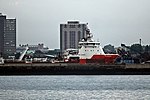Seaforth Battery
Seaforth Battery, Seaforth, Merseyside, England. was built to protect shipping on the River Mersey. Constructed as part of the defences of the Mersey Docks, the battery was designed to engage ships using the Rock Channel head on as well as the other shipping channels. The battery supported Fort Perch Rock, which was located opposite on the Wirral bank of the river. It was completed at the end of 1879 at a cost of £19,109.The main armament comprised four 12.5-inch RML guns which were mounted in armoured granite casemates. These were installed soon after completion of the battery. These were soon augmented in 1894 with two 4.7-inch Quick Fire guns which were originally sent to arm Fort Perch Rock. These were suitable for engaging fast torpedo boats. In 1898 a fire control centre for the 4.7-inch guns was added at the east end of the battery. In 1903 the four 12.5-inch RMLs were removed, as they were obsolete. In 1907 two of the 12.5-inch RML gun casemates were opened out to mount searchlights.In 1928 a review of the defences of the Mersey was undertaken and it was decided that Seaforth battery was no longer required. The battery was dismantled and the land returned to the harbour board in 1929.
Excerpt from the Wikipedia article Seaforth Battery (License: CC BY-SA 3.0, Authors).Seaforth Battery
E 20,
Geographical coordinates (GPS) Address Nearby Places Show on map
Geographical coordinates (GPS)
| Latitude | Longitude |
|---|---|
| N 53.452 ° | E -3.02 ° |
Address
Liverpool Port
E 20
L20 1EF , Seaforth
England, United Kingdom
Open on Google Maps








